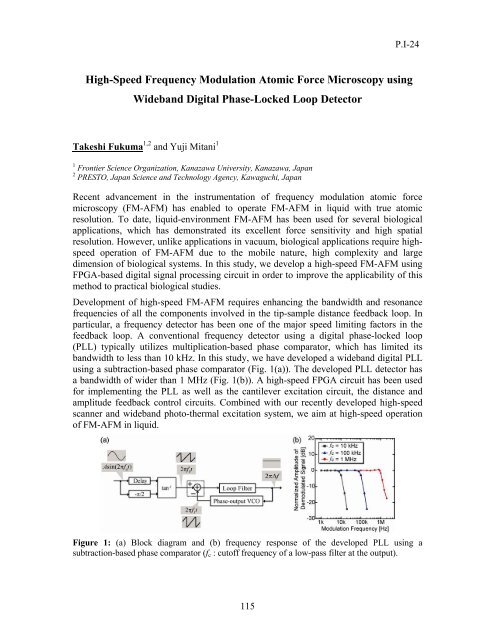Noncontact Atomic Force Microscopy - Yale School of Engineering ...
Noncontact Atomic Force Microscopy - Yale School of Engineering ...
Noncontact Atomic Force Microscopy - Yale School of Engineering ...
Create successful ePaper yourself
Turn your PDF publications into a flip-book with our unique Google optimized e-Paper software.
P.I-24<br />
High-Speed Frequency Modulation <strong>Atomic</strong> <strong>Force</strong> <strong>Microscopy</strong> using<br />
Wideband Digital Phase-Locked Loop Detector<br />
Takeshi Fukuma 1,2 and Yuji Mitani 1<br />
1 Frontier Science Organization, Kanazawa University, Kanazawa, Japan<br />
2 PRESTO, Japan Science and Technology Agency, Kawaguchi, Japan<br />
Recent advancement in the instrumentation <strong>of</strong> frequency modulation atomic force<br />
microscopy (FM-AFM) has enabled to operate FM-AFM in liquid with true atomic<br />
resolution. To date, liquid-environment FM-AFM has been used for several biological<br />
applications, which has demonstrated its excellent force sensitivity and high spatial<br />
resolution. However, unlike applications in vacuum, biological applications require highspeed<br />
operation <strong>of</strong> FM-AFM due to the mobile nature, high complexity and large<br />
dimension <strong>of</strong> biological systems. In this study, we develop a high-speed FM-AFM using<br />
FPGA-based digital signal processing circuit in order to improve the applicability <strong>of</strong> this<br />
method to practical biological studies.<br />
Development <strong>of</strong> high-speed FM-AFM requires enhancing the bandwidth and resonance<br />
frequencies <strong>of</strong> all the components involved in the tip-sample distance feedback loop. In<br />
particular, a frequency detector has been one <strong>of</strong> the major speed limiting factors in the<br />
feedback loop. A conventional frequency detector using a digital phase-locked loop<br />
(PLL) typically utilizes multiplication-based phase comparator, which has limited its<br />
bandwidth to less than 10 kHz. In this study, we have developed a wideband digital PLL<br />
using a subtraction-based phase comparator (Fig. 1(a)). The developed PLL detector has<br />
a bandwidth <strong>of</strong> wider than 1 MHz (Fig. 1(b)). A high-speed FPGA circuit has been used<br />
for implementing the PLL as well as the cantilever excitation circuit, the distance and<br />
amplitude feedback control circuits. Combined with our recently developed high-speed<br />
scanner and wideband photo-thermal excitation system, we aim at high-speed operation<br />
<strong>of</strong> FM-AFM in liquid.<br />
Figure 1: (a) Block diagram and (b) frequency response <strong>of</strong> the developed PLL using a<br />
subtraction-based phase comparator (fc : cut<strong>of</strong>f frequency <strong>of</strong> a low-pass filter at the output).<br />
115















